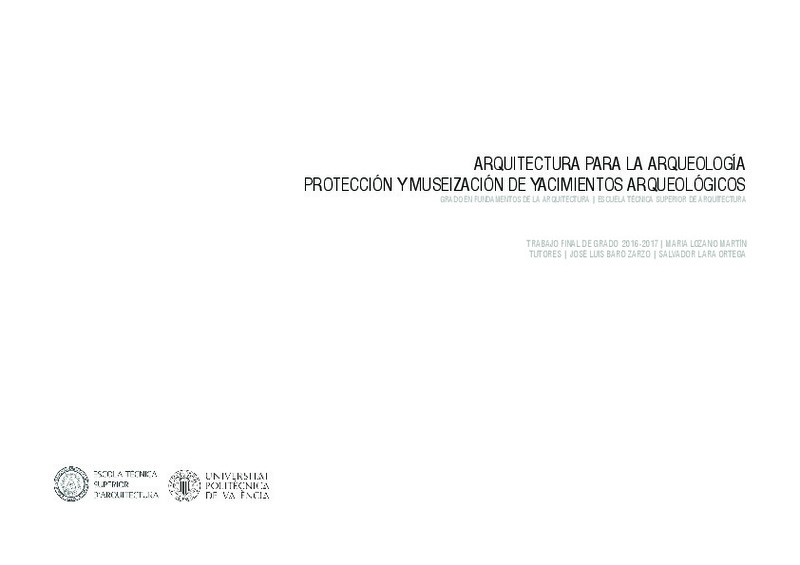JavaScript is disabled for your browser. Some features of this site may not work without it.
Buscar en RiuNet
Listar
Mi cuenta
Estadísticas
Ayuda RiuNet
Admin. UPV
Arquitectura para la Arqueología. Protección y musealización de yacimientos arqueológicos
Mostrar el registro sencillo del ítem
Ficheros en el ítem
| dc.contributor.advisor | Lara Ortega, Salvador
|
es_ES |
| dc.contributor.advisor | Baró Zarzo, José Luis
|
es_ES |
| dc.contributor.author | Lozano Martín, Maria
|
es_ES |
| dc.date.accessioned | 2018-05-23T09:49:31Z | |
| dc.date.available | 2018-05-23T09:49:31Z | |
| dc.date.created | 2017-07-14 | |
| dc.date.issued | 2018-05-23 | es_ES |
| dc.identifier.uri | http://hdl.handle.net/10251/102443 | |
| dc.description.abstract | La excavación de un yacimiento arqueológico no acaba con el descubrimiento y documentación de los restos encontrados. Casi inmediatamente se requiere abordar una delicada tarea que atañe tanto a la protección del sitio como a la divulgación pública de los hallazgos. El cumplimiento de este doble objetivo implica la participación no sólo de la Arqueología sino también de disciplinas como la Arquitectura. Ésta proporciona el marco físico de protección de los restos patrimoniales frente a la intemperie y los actos vandálicos, y posibilita la organización de unos espacios a su alrededor, preparados para dar a conocer al público el yacimiento. Este trabajo pretende, pues, indagar en las aportaciones de la Arquitectura en el campo de la Arqueología. A través del análisis de unos casos escogidos por su notable valor arquitectónico la investigación se dirige, en última instancia, a la elaboración de un protocolo de recomendaciones que puedan resultar útiles a la hora de acometer este tipo de intervenciones. | es_ES |
| dc.description.abstract | The excavation of an archaeological site does not end with the discovery and documentation of the remains found. It is almost immediately necessary to address a delicate task that concerns the protection of the site and the public disclosure of the findings. The fulfillment of this double objective implies the participation not only Archeology but also other disciplines like Architecture. It provides the physical framework to preserve the archeological heritage against the outdoors and acts of vandalism, and it allows the organization of spaces around it, prepared to make the site known. This work aims, therefore, to investigate the contributions of Architecture in the field of Archeology. Through the analysis of cases chosen for their remarkable architectural value the research is ultimately directed to elaborate a protocol of recommendations that may be useful for undertaking this type of interventions. | es_ES |
| dc.format.extent | 52 | es_ES |
| dc.language | Español | es_ES |
| dc.publisher | Universitat Politècnica de València | es_ES |
| dc.rights | Reserva de todos los derechos | es_ES |
| dc.subject | Cubiertas de protección | es_ES |
| dc.subject | Arqueología | es_ES |
| dc.subject | Preservación | es_ES |
| dc.subject | Intervenciones arquitectónicas | es_ES |
| dc.subject | Patrimonio arqueológico | es_ES |
| dc.subject | Protective covers | es_ES |
| dc.subject | Archeology | es_ES |
| dc.subject | Preservation | es_ES |
| dc.subject | Architectural interventions | es_ES |
| dc.subject | Archeological heritage | es_ES |
| dc.subject.classification | COMPOSICION ARQUITECTONICA | es_ES |
| dc.subject.other | Grado en Fundamentos de la Arquitectura-Grau en Fonaments de l'Arquitectura | es_ES |
| dc.title | Arquitectura para la Arqueología. Protección y musealización de yacimientos arqueológicos | es_ES |
| dc.type | Proyecto/Trabajo fin de carrera/grado | es_ES |
| dc.rights.accessRights | Abierto | es_ES |
| dc.description.bibliographicCitation | Lozano Martín, M. (2017). Arquitectura para la Arqueología. Protección y musealización de yacimientos arqueológicos. http://hdl.handle.net/10251/102443 | es_ES |
| dc.description.accrualMethod | TFGM | es_ES |
| dc.relation.pasarela | TFGM\57551 | es_ES |
Este ítem aparece en la(s) siguiente(s) colección(ones)
-
ETSA - Trabajos académicos [4687]
Escuela Técnica Superior de Arquitectura






